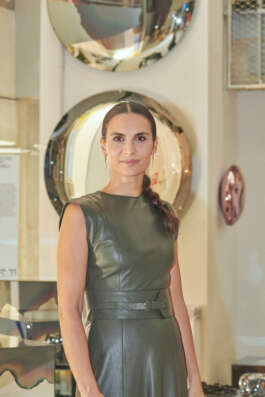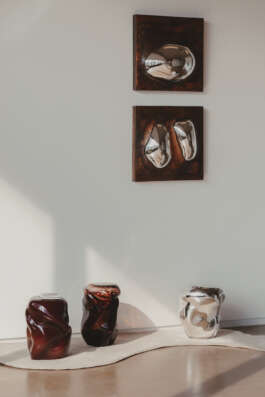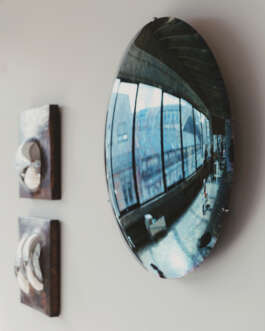



© Homa
COLLECTIBLE In-Depth
Homa
March 2025
This series, COLLECTIBLE In-Depth, unveils the backstage of contemporary creation. Tackling various topics from personal designer processes to the position of collectible design on the global design market, COLLECTIBLE In-Depth offers different views to suit all tastes. Today we speak with Homa.
C: What role does storytelling play in enhancing the value and appreciation of collectible design objects within a collector’s portfolio?
Homa: For HOMA each piece that we create embodies a narrative that goes beyond aesthetic or functional attributes; it fosters emotional connections and offers historical context. Each piece links the collector to cultural heritage as well as to natural resources from the earth since materials and their sourcing from around our Anatolian landscapes play such a key role in how we create and design. As a designer, I aim to enrich these narratives, ensuring that each object serves as a unique expression of both the owner's personal journey and the designer's creative evolution. Over time, these stories transform the pieces into significant heirloom pieces and historical artifacts, deepening their value and meaning within a collector's portfolio.
C: How do you question or challenge functionality in your design process?
H: My design process often resembles that of a sculptor, where glass is my primary medium. I enjoy shaping and forming it, allowing its inherent beauty to shine. I often layer or combine glass with materials like marble, brass, ceramic, and copper, exploring how these combinations can create unique, sculptural forms. This mix of technique with elements and process with experimentation makes the final product much more than its functional description of say, 'mirror', 'door handle' or 'lamp', for example. As a mirror artist, I also focus on the reflective qualities of glass, using chemistry to achieve special effects and patterns in the reflections. For me, each piece is a dialogue between the materials and their surroundings, transforming spaces into something extraordinary. I embrace the playful exploration of these materials, seeking those magical moments that elevate functionality into art. The goal is to craft objects that resonate on multiple levels, inviting curiosity and interplay with all of the senses as well as enriching the experience of those who interact with them.
C: How do you navigate the tension between innovation and tradition in your approach to designing collectible objects?
H: Navigating the tension between innovation and tradition is an exhilarating journey for me. I grew up in Austria, where I studied and lived, before moving back to Turkey. This country has served as a crossroads of cultures for centuries, enriching it with diverse materials, craftsmanship and a celebration of both tradition and innovation. Now, I find myself navigating between Vienna and Istanbul, which offers me a unique perspective on how design and craftsmanship operate differently in each culture.
In my studio, we engage in production, mirroring, and experimental work. This hands-on approach allows me to blend traditional craftsmanship with modern techniques, pushing boundaries and exploring new creative avenues. I cherish the human touch in every piece; even the smallest imperfections add character and uniqueness. We have gained a deep understanding of traditional techniques and handcrafting but now are taking that one step further by using experimental interdisciplinary techniques; often even inventing our own processes. This is why a lot of our pieces are almost spontaneous – we are getting pieces of art from an unpredictable flow. For example, from plain glass we can acquire a concave shape – using 1200 degree heat to shape and manipulate its DNA. Adding to that is the second process of mirroring which brings texture and three dimensionality.
In our atelier we are inspired by different factors. Sometimes by mistake and chance a new piece is created during the process and may be different than the idea we may have gone in with. This is the magic of the process. Sometimes mistakes and accidents end up revealing themselves as an art piece. Ultimately, my work aims to tell a story -where the craftsmanship of the past meets the possibilities of the present, creating pieces that resonate with both history and innovation.
C: How did you get into collectible design? Why did you focus your practice on this type of design rather than industrial design?
H: Just stopping at pieces that have received praise or cult status and that people want to get on a waiting list for can feel stifling for us. Our passion lies in constant creation and re-invention - playing with materials and pushing boundaries to keep birthing new concepts, formulations and perspectives. Sometimes our studio feels more like a chemistry lab than an art space even! This drive and instinct for creation have led us to focus on collectible design, as it allows us the freedom to explore and innovate in ways that industrial design simply doesn’t offer. Collectible design encourages us to embrace the unique and the unconventional. My own journey began with learning the hand-mirroring and glass art technique from third-generation masters. In Istanbul, the balance of contrasts, the harmony within dissonance, and the new stories and challenges encountered every day have been a constant source of inspiration for me. Ultimately, collectible design is not just about creating unique one-of-a-kind objects; it’s about honoring the artistry and human touch behind each piece, ensuring that every creation is a unique reflection of our journey and the cultures that inspire us.
C: How can collectors contribute to the preservation and promotion of cultural heritage through their acquisitions of collectible design pieces?
H: Collectors have a transformative power in preserving and promoting cultural heritage through their choices in collectible design. By selecting unique pieces that reflect exceptional craftsmanship, they not only support artisans but also keep traditional techniques alive. When collectors invest in collectible design, they are not just enhancing their spaces; they are curating a narrative that speaks to their identity and values. It’s about surrounding themselves with objects that tell a story and evoke feelings—pieces that become part of their personal history. This thoughtful selection celebrates the artistry and innovation behind each creation, elevating their collections into something that transcends trends and fads. In this way, collectors become part of a dynamic conversation about the past and present, breathing new life into cultural narratives and ensuring that craftsmanship continues to thrive in a fresh and relevant way.

© Homa

© Homa

© Homa
COLLECTIBLE In-Depth
Homa
March 2025
This series, COLLECTIBLE In-Depth, unveils the backstage of contemporary creation. Tackling various topics from personal designer processes to the position of collectible design on the global design market, COLLECTIBLE In-Depth offers different views to suit all tastes. Today we speak with Homa.
C: What role does storytelling play in enhancing the value and appreciation of collectible design objects within a collector’s portfolio?
Homa: For HOMA each piece that we create embodies a narrative that goes beyond aesthetic or functional attributes; it fosters emotional connections and offers historical context. Each piece links the collector to cultural heritage as well as to natural resources from the earth since materials and their sourcing from around our Anatolian landscapes play such a key role in how we create and design. As a designer, I aim to enrich these narratives, ensuring that each object serves as a unique expression of both the owner's personal journey and the designer's creative evolution. Over time, these stories transform the pieces into significant heirloom pieces and historical artifacts, deepening their value and meaning within a collector's portfolio.
C: How do you question or challenge functionality in your design process?
H: My design process often resembles that of a sculptor, where glass is my primary medium. I enjoy shaping and forming it, allowing its inherent beauty to shine. I often layer or combine glass with materials like marble, brass, ceramic, and copper, exploring how these combinations can create unique, sculptural forms. This mix of technique with elements and process with experimentation makes the final product much more than its functional description of say, 'mirror', 'door handle' or 'lamp', for example. As a mirror artist, I also focus on the reflective qualities of glass, using chemistry to achieve special effects and patterns in the reflections. For me, each piece is a dialogue between the materials and their surroundings, transforming spaces into something extraordinary. I embrace the playful exploration of these materials, seeking those magical moments that elevate functionality into art. The goal is to craft objects that resonate on multiple levels, inviting curiosity and interplay with all of the senses as well as enriching the experience of those who interact with them.
C: How do you navigate the tension between innovation and tradition in your approach to designing collectible objects?
H: Navigating the tension between innovation and tradition is an exhilarating journey for me. I grew up in Austria, where I studied and lived, before moving back to Turkey. This country has served as a crossroads of cultures for centuries, enriching it with diverse materials, craftsmanship and a celebration of both tradition and innovation. Now, I find myself navigating between Vienna and Istanbul, which offers me a unique perspective on how design and craftsmanship operate differently in each culture.
In my studio, we engage in production, mirroring, and experimental work. This hands-on approach allows me to blend traditional craftsmanship with modern techniques, pushing boundaries and exploring new creative avenues. I cherish the human touch in every piece; even the smallest imperfections add character and uniqueness. We have gained a deep understanding of traditional techniques and handcrafting but now are taking that one step further by using experimental interdisciplinary techniques; often even inventing our own processes. This is why a lot of our pieces are almost spontaneous – we are getting pieces of art from an unpredictable flow. For example, from plain glass we can acquire a concave shape – using 1200 degree heat to shape and manipulate its DNA. Adding to that is the second process of mirroring which brings texture and three dimensionality.
In our atelier we are inspired by different factors. Sometimes by mistake and chance a new piece is created during the process and may be different than the idea we may have gone in with. This is the magic of the process. Sometimes mistakes and accidents end up revealing themselves as an art piece. Ultimately, my work aims to tell a story -where the craftsmanship of the past meets the possibilities of the present, creating pieces that resonate with both history and innovation.
C: How did you get into collectible design? Why did you focus your practice on this type of design rather than industrial design?
H: Just stopping at pieces that have received praise or cult status and that people want to get on a waiting list for can feel stifling for us. Our passion lies in constant creation and re-invention - playing with materials and pushing boundaries to keep birthing new concepts, formulations and perspectives. Sometimes our studio feels more like a chemistry lab than an art space even! This drive and instinct for creation have led us to focus on collectible design, as it allows us the freedom to explore and innovate in ways that industrial design simply doesn’t offer. Collectible design encourages us to embrace the unique and the unconventional. My own journey began with learning the hand-mirroring and glass art technique from third-generation masters. In Istanbul, the balance of contrasts, the harmony within dissonance, and the new stories and challenges encountered every day have been a constant source of inspiration for me. Ultimately, collectible design is not just about creating unique one-of-a-kind objects; it’s about honoring the artistry and human touch behind each piece, ensuring that every creation is a unique reflection of our journey and the cultures that inspire us.
C: How can collectors contribute to the preservation and promotion of cultural heritage through their acquisitions of collectible design pieces?
H: Collectors have a transformative power in preserving and promoting cultural heritage through their choices in collectible design. By selecting unique pieces that reflect exceptional craftsmanship, they not only support artisans but also keep traditional techniques alive. When collectors invest in collectible design, they are not just enhancing their spaces; they are curating a narrative that speaks to their identity and values. It’s about surrounding themselves with objects that tell a story and evoke feelings—pieces that become part of their personal history. This thoughtful selection celebrates the artistry and innovation behind each creation, elevating their collections into something that transcends trends and fads. In this way, collectors become part of a dynamic conversation about the past and present, breathing new life into cultural narratives and ensuring that craftsmanship continues to thrive in a fresh and relevant way.

© Homa

© Homa
Contact
info@collectible.design
VIP PORTAL
EXHIBITOR PORTAL
PRIVACY POLICY
© 2025 Collectible
Contact
info@collectible.design
VIP PORTAL
EXHIBITOR PORTAL
PRIVACY POLICY
© 2025 Collectible